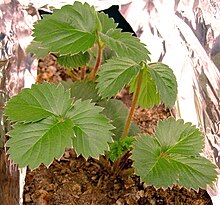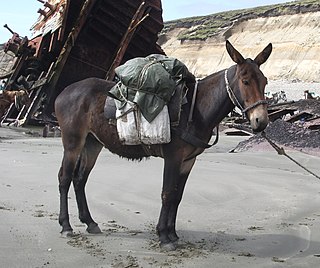
In biology, a hybrid is the offspring resulting from combining the qualities of two organisms of different varieties, species or genera through sexual reproduction. Generally, it means that each cell has genetic material from two different organisms, whereas an individual where some cells are derived from a different organism is called a chimera. Hybrids are not always intermediates between their parents, but can show hybrid vigor, sometimes growing larger or taller than either parent. The concept of a hybrid is interpreted differently in animal and plant breeding, where there is interest in the individual parentage. In genetics, attention is focused on the numbers of chromosomes. In taxonomy, a key question is how closely related the parent species are.

A berry is a small, pulpy, and often edible fruit. Typically, berries are juicy, rounded, brightly colored, sweet, sour or tart, and do not have a stone or pit, although many pips or seeds may be present. Common examples of berries in the culinary sense are strawberries, raspberries, blueberries, blackberries, white currants, blackcurrants, and redcurrants. In Britain, soft fruit is a horticultural term for such fruits.

Fragaria is a genus of flowering plants in the rose family, Rosaceae, commonly known as strawberries for their edible fruits. There are more than 20 described species and many hybrids and cultivars. The most common strawberries grown commercially are cultivars of the garden strawberry, a hybrid known as Fragaria × ananassa. Strawberries have a taste that varies by cultivar, and ranges from quite sweet to rather tart. Strawberries are an important commercial fruit crop, widely grown in all temperate regions of the world.
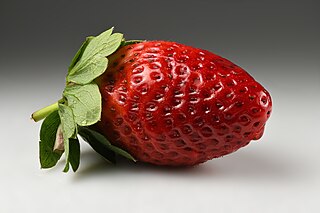
The garden strawberry is a widely grown hybrid species of the genus Fragaria, collectively known as the strawberries, which are cultivated worldwide for their fruit. The fruit is widely appreciated for its characteristic aroma, bright red color, juicy texture, and sweetness. It is consumed in large quantities, either fresh or in such prepared foods as jam, juice, pies, ice cream, milkshakes, and chocolates. Artificial strawberry flavorings and aromas are also widely used in products such as candy, soap, lip gloss, perfume, and many others.

Fragaria virginiana, known as Virginia strawberry, wild strawberry, common strawberry, or mountain strawberry, is a North American strawberry that grows across much of the United States and southern Canada. It is one of the two species of wild strawberry that were hybridized to create the modern domesticated garden strawberry.

The musk strawberry or hautbois strawberry, is a species of strawberry native to Europe. Its French name hautbois strawberry may be anglicised as hautboy strawberry. The plants are hardy and can survive in many weather conditions. They are cultivated commercially on a small scale, particularly in Italy. The fruit are small and round; they are used in the gourmet community for their intense aroma and flavour, which has been compared to a mixture of regular strawberry, raspberry and pineapple. Popular cultivated varieties include 'Capron' and 'Profumata di Tortona'.

Fragaria vesca, commonly called the wild strawberry, woodland strawberry, Alpine strawberry, Carpathian strawberry or European strawberry, is a perennial herbaceous plant in the rose family that grows naturally throughout much of the Northern Hemisphere, and that produces edible fruits.

Fragaria chiloensis, the beach strawberry, Chilean strawberry, or coastal strawberry, is one of two species of wild strawberry that were hybridized to create the modern garden strawberry. It is native to the Pacific Ocean coasts of North and South America.

Fragaria nilgerrensis is a species of flowering plant in the family Rosaceae. It is a wild strawberry native to southern and southeast Asia. Its fruit are white to light pink, with poor flavour, and the fruit is of no commercial value. It is similar in appearance to F. moupinensis.
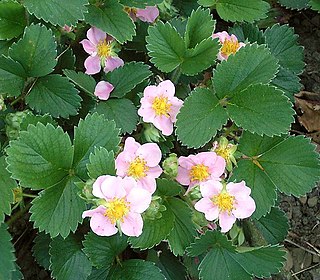
There are several commercially important hybrids between Fragaria and Comarum species in existence. A name for Fragaria × Comarum is available as × Comagaria Büscher & G.H. Loos in Veroff. [Bohumer Bot. Ver. 2(1): 6. 2010], along with the combination × Comagaria rosea (Mabb.) Büscher & G.H. Loos.
Xanthomonas fragariae is a species of bacteria. It causes a leaf spot disease found in strawberries. The type strain is NCPPB1469 from Fragaria chiloensis var. ananassa.

The Marshall strawberry is a cultivated variety of Fragaria ananassa, that is known for an "exceptional" taste and had been described as "the finest eating strawberry" in America.

Strawberry vein banding virus (SVBV) is a plant pathogenic virus and a member of the family Caulimoviridae.
Fragaria × bringhurstii is a naturally occurring hybrid species of wild strawberry native to the West Coast of the United States. The species results from the natural intercrossing of Fragaria vesca and Fragaria chiloensis, native species whose ranges overlap in that region.

Pineberry is a white strawberry cultivar with red seeds and a pineapple-like flavor.
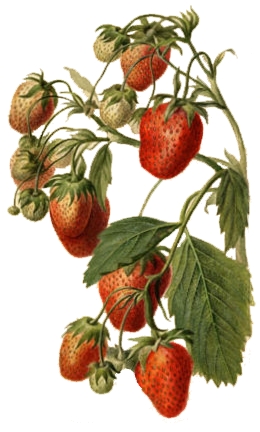
The breeding of strawberries started with the selection and cultivation of European strawberry species in western Europe in the 15th century while a similar discovery and cultivation occurred in Chile. The most commonly consumed strawberry species in modern times is the garden strawberry, a species derived from hybridization of two other species, with the scientific name Fragaria × ananassa, but there are many species of strawberries, several others of which are cultivated to some extent. The strawberry species fall into several different genetic types, based on their number of chromosomes. Strawberry growers have employed many breeding techniques, starting with traditional plant breeding and then moving on to molecular breeding and genetic engineering in the 20th century.
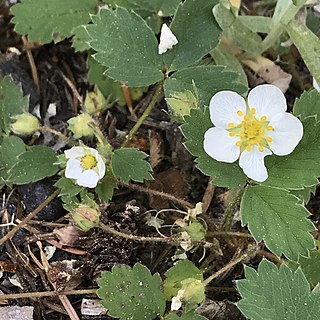
Fragaria cascadensis is a species of strawberry found in the Cascades Mountains described in 2012. The vernacular name Cascade strawberry was suggested by the describing author.

The following outline is provided as an overview of and topical guide to strawberries:

Strawberries in the United States are almost entirely grown in California – 86% of fresh and 98% of frozen in 2017 – with Florida a distant second. Of that 30.0% was from Monterey, 28.6% from Ventura, 20.0% from Santa Barbara, 10.0% from San Luis Obispo, and 9.2% from Santa Cruz. The Watsonville/Salinas strawberry zone in Santa Cruz/Monterey, and the Oxnard zone in Ventura, contribute heavily to those concentrations.
